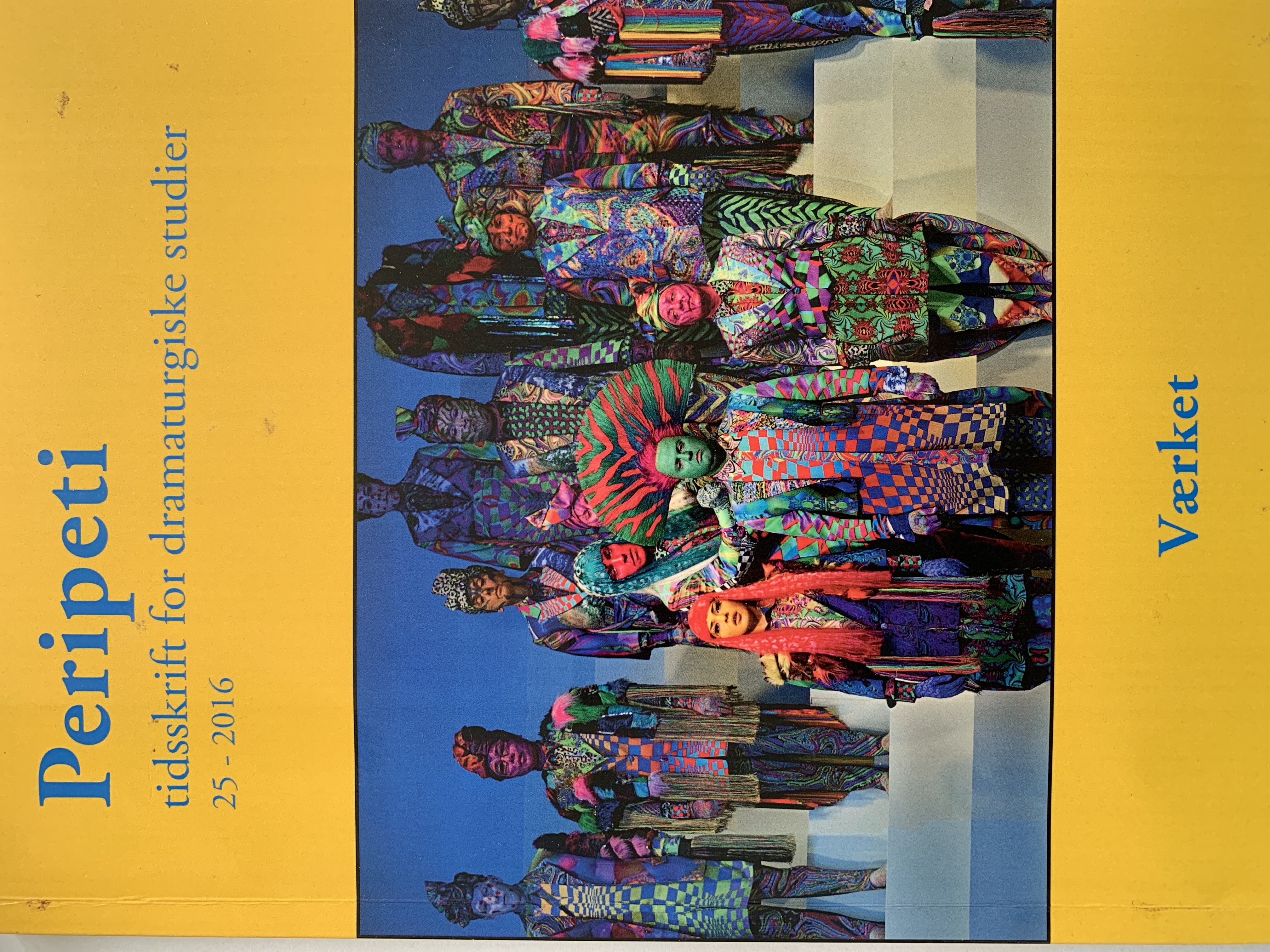Participation som kunst-værk
DOI:
https://doi.org/10.7146/peri.v13i25.109571Nøgleord:
deltagelse, værkbegrebet, performancekunst, rimini protokoll, agens, værkets topologiResumé
The article asks whether participatory art radically alters the character of the work of art. This question is first explored through the concept of the aesthetic work of art that emerged during the aestheticism of the 19th century, and that is characterized by a stable and innately complete composition, before that concept is argued against with the opposing thesis that participatory works of art ‘need’ to construct a system or function frame that allows for participant agency in the concrete unfolding of the work. This framing must be able to, first, distinguish between elements (actions, objects, expressions, etc.) that either belong or not to a particular work of art and, second, support the participant’s perceptual interplay between material (inter)action and reflective observation.
Referencer
Bishop, C. (2012). Artificial Hells. Cambridge Massachusetts: October.
Bourdieu, P. (1996). The Rules of Art. Genesis and Structure of the Literary Field. Cambridge: Polity Press.
Bourriaud, N. (2002). Relational Aesthetics. Dijon: Les presses du réel.
Breidbach, O. (2003). “The Beauties and the Beautiful.” In E. Voland & K. Grammer (Eds.), Evolutionary Aesthetics (pp. 39–68). Springer.
Bürger, P. (1974). Theorien der Avantgarde. Frankfurt a. M.: Suhrkamp.
Burnham, J. (1968). Beyond Modern Sculpture. New York: George Braziller.
Cohn, D. (1999). The Distinction of Fiction. Princeton: The John Hopkins University Press.
DeLanda, M. (2002). Intensive Science and Virtual Philosophy. New York: Columbia University Press.
LeWitt, S. (1996). Paragraphes on Conceptual Art. In K. Stiles & P. Selz (Eds.), Theories and Documents of Contemporary Art- A Sourcebook of Artists’ Writing. Berkeley, Los Angeles: University of California Press.
Dezeuze, A. (2010). The “do-it-yourself ” artwork : participation from fluxus to new media. Rethinking art’s histories.
Eco, U. (1989). The Open Work. Cambridge, Mass.: Havard University Press.
Eco, U. (2004). On Beauty - A History of a Western Idea. London: Secker&Wartburg.
Fischer-Lichte, E. (2008). The Transformative Power of Performance: New Aesthetics. New York, London: Routlegde
Gadamer, H.-G. (1977). Die Aktualität des Schönen. Stuttgart: Reclam Verlag.
Gade, S. (2015) ”EU-teatret kommer til et hjem nær dig.” Anmeldelse i Weekendavisen 11.9.2015.
Gell, A. (1998). Art and agency - An Anthropoligical Theory. Oxford: Oxford University Press.
Hegel, G. W. F. (2005). Philosophie der Kunst. Frankfurt a. M.: suhrkamp.
Heinrich, F. (2008). Interaktiv digtial installationskunst - teori og analyse. Copenhagen: Multivers.
Heinrich, F. (2014). Performing Beauty in Participatory Art and Culture. London, NewYork: Routlegde.
Kant, I. (1790). “Critique of Judgment.” Critique of Judgment, 97–199.
Keller, R. (2011). “The Sociology of Knowledge Approach to Discourse (SKAD).” Human Studies, 34(1), 43–65.
Kester, G. (2004). Conversation pieces: Community and Communication in Modern Art. Berkeley, Los Angeles,´London: University of California Press
Kwastek, K. (n.d.). Aesthetics of Interaction in Digital Art. Cambridge, Mass.: The MIT Press.
Luhmann, N. (2000). Art as a social system. Stanford: Stanford University Press
Margolis, E., & Laurence, S. (2011). “Concepts.” The Stanford Encyclopedia of Philosophy.
Moritz, K. P. (1788). Über die bildende Nachahmung des Schönen. Braunschweig: Schul-Buchhandlung.
Popper, F. (1975). Art - Action and Participation. New York: New York University Press.
Pudelek, J.-P. (n.d.). ”Werk”. In K. Barck (Ed.), Ästhetische Grundbegriffe. Stuttgart, Weimar: Verlag Metzler.
Rancière, J. (2006). “Problems and Transformations of Critical Art”. In Participation. London: Whitechapel Gallery.
Rundell, J. (1994). “Creativity and judgment: Kant on Reason and Imagination”. In G. Robinson & J.
Rundell (Eds.), Rethinking Imagination: Culture and Creativity. London, NewYork: Routledge.
Schultz, L.L. (2013). ”Værker der virker - om aktuelle forskydninger i værkbegrebet”. Aarhus, Peripeti, 8.
Stott, T. (2015). Play and Participation. London, NewYork: Routledge.
Sütterlin, C. (2003). “From Sign and Schema to Iconic Representation. Evolutionary Aesthetics Of Pictorial´Art”. In E. Voland and K. Grammer (Ed.), Evolutionary Aesthetics. Berlin, Heidelberg, New York: Springer-Verlag.
Walsch, R. (2007). The Rhetoric of Fictionality. Narrative Theory and the Idea of Fiction. Columbus: The Ohio State University.
Walton, K. (1990). Mimesis as Make Believe: On the Foundations of the Representational Arts. Cambridge, Mass.: Havard University Press.
Downloads
Publiceret
Citation/Eksport
Nummer
Sektion
Licens
Det følgende vedrører alle Peripeti-udgivelser fra 2024, nr. 39, og senere:
Peripeti er et Diamond Open Access-tidsskrift, der giver direkte open acces til publiceret indhold ud fra princippet om, at det at gøre forskning frit tilgængelig for offentligheden understøtter en større global udveksling af viden.
Forfattere skal ikke betale for indsendelse, redigering eller offentliggørelse af artikler.
Forfattere, der bidrager til Peripeti, bevarer ophavsretten til deres artikler.
Forfattere accepterer at udgive artikler under en Creative Commons CC-BY-NC 4.0-licens. Vilkårene for denne licens tillader brugere frit at kopiere og videredistribuere materialet i ethvert medie eller format og at tilpasse, transformere og bygge videre på materialet, så længe der gives passende kreditering, et link til licensen gives, og eventuelle ændringer angives. Brugere må ikke dele eller tilpasse materialet til kommercielle formål uden samtykke fra licensgiveren. Brugen af licensen må ikke på nogen måde antyde, at licensgiveren støtter tredjeparten eller dennes brug. Licensen kan ikke tilbagekaldes.
Forfattere opfordres til at lægge deres artikler ud på personlige og/eller institutionelle hjemmesider for at sikre endnu større offentlig adgang efter udgivelsen. Forfattere har ret til at arkivere deres artikler i fondes og offentlige institutioners arkiver, men Peripeti anmoder om, at forfattere bruger et direkte link til den publicerede artikel på tidsskriftets hjemmeside, når det er muligt, da Peripeti som en ikke-kommerciel, offentligt finansieret udgiver er afhængig af niveauet af brugeraktivitet på tidsskriftets hjemmeside.
Vedrørende tidligere udgivelser, indtil 2024, herunder nr. 38:
Ophavsretten deles mellem Peripeti og forfatteren/forfatterne. Tidsskriftet er et open access-tidsskrift, der giver direkte adgang til alt indhold baseret på princippet om, at det at gøre forskning frit tilgængelig for offentligheden understøtter en større global udveksling af viden. Brugere kan frit kopiere og dele materiale i ethvert medie eller format, så længe der gives passende kreditering. Enhver anden brug kræver skriftligt samtykke fra indehaverne af ophavsretten.





